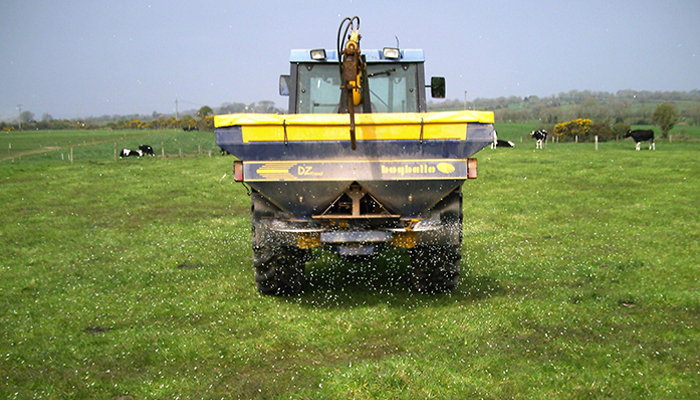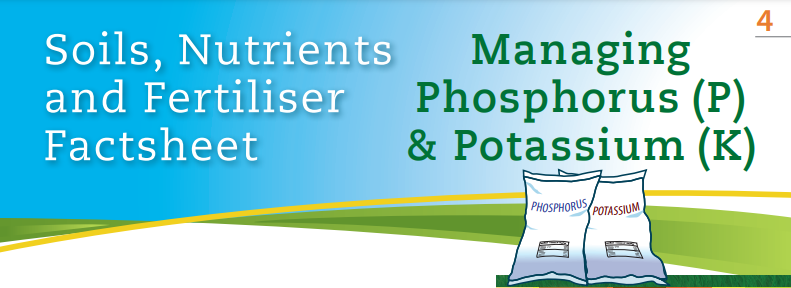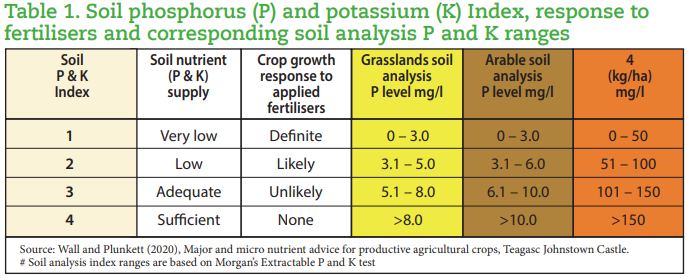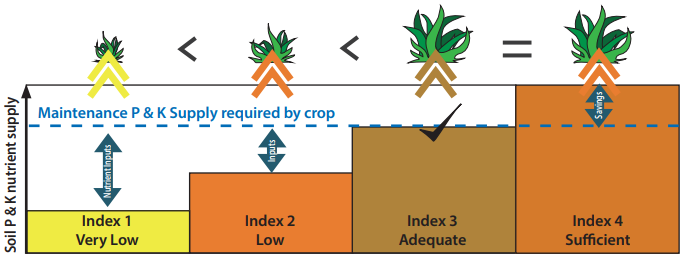19 February 2022
Managing Phosphorus (P) & Potassium (K) Factsheet

Teagasc recently published a compendium of 20 factsheets providing the latest technical advice on soils, nutrients and fertiliser. The fourth of these is about Managing Phosphorus (P) & Potassium (K) and can be read here. All 20 will be published here on Teagasc Daily
Farmers are urged to focus on Nutrient management planning, optimisation of soil fertility, using organic manures strategically and increasing clover in swards, all balanced with prudent fertiliser usage.

When N-P-K compound fertiliser prices are high, it will be tempting to reduce fertiliser P and K applications. Decisions should only be made based on soil analysis results. In the absence of soil analysis, one must assume soil fertility is at Index 3 and either too little (on Index 1 & 2) or too much (Index 4) P & K fertiliser could be applied, leading to a poor return on investment


Soil Fertility Level
P & K fertiliser strategy on low fertility soils (Index 1&2)
The strategy to improve soil fertility on these soils is; firstly, to apply the P and K required to grow the crop during the season and secondly, an additional application of these nutrients is required to build-up soil fertility for future seasons
- At the very least, apply the recommended maintenance P & K rates to meet the crop growing needs during the season
- Target organic manures to these hungry Index 1&2 soils to fully utilise the P and K
- For moderately stocked systems (beef, sheep, or dairy replacements), maintenance application rates of P & K only on the grazing area could be applied in the short term without drastically compromising soil fertility
- Where it is planned to harvest silage or arable crops, it is essential to replenish the large crop P and K offtakes from the soil. Organic manure applications will help to supply the majority of the P and K requirements. A nutrient top-up with a suitable fertiliser compound will balance the N, P, K & S in line with crop demand
P & K fertiliser strategy on soils with optimum fertility (Index 3)
Index 3 soils have an adequate supply of P and K to sustain grass growth over the season. The fertiliser strategy for these soils is to replace P and K removed and to maintain the optimum soil fertility. Nitrogen use efficiency is also optimised when soil fertility levels are good (Index 3)
- Grazing livestock typically recycle 60% of the P and 90% of the K consumed in dung and urine. Relatively small quantities of P and K maintain fertility on these Index 3 soils
- Adjust the maintenance P and K application rates according to the farming system type (crop > dairy > dry-stock and accounting for difference in stocking rate)
- On a lowly stocked dry-stock farms (<130 kg/ha Organic N) where grass demand is lower, there may be more scope to reduce the maintenance rates (50%) of fertiliser P and K applications for one year only
- All fields where P and K applications were reduced or omitted should be re-sampled next year to monitor and react to changes in soil fertility
Soils with very high P & K fertility (Index 4)
It is prudent to make P and K savings on all fields with Index 4 soils
- Omit P applications for two to three years and re-sample to monitor changes in soil P levels
- Omit K applications for one year and either re-sample next year or revert to K Index 3 advice until soils are re-sampled
- Apply straight N & S in the form of protected urea to balance crop N & S requirements
Deirdre Hennessy, Seamus Kearney, Mark Plunkett, David Wall, Mark Moore (Editor), Pat Murphy, Stan Lalor, were the main contributors to this series of leaflets. Numerous colleagues from Teagasc AGRIP, CELUP, REDP, Signpost, PR dept. and advisory service also participated.
To access the entire compendium of 20 factsheets see Soils, Nutrients and Fertiliser Factsheets Find more information on this topic in Soil & Soil Fertility
